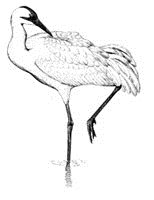North American Crane Working Group

Proceedings of the North American Crane Workshop
Date of this Version
2023
Document Type
Article
Citation
Proceedings of the North American Crane Workshop (2023) 16: 218–223
Abstract
The Pecos River Valley is an important stopover area for both migrating and wintering sandhill cranes (Grus canadensis) in southeastern New Mexico. The combination of shallow impoundments and a playa lake at Bitter Lake National Wildlife Refuge, off-refuge shallow ponds and riverine wetlands, and approximately 20,000 ha of nearby irrigated farmlands in Chaves County provided roosting and foraging areas used by the cranes. Once per week sandhill cranes were counted when departing their roosts during September through April 2005–2024. The fall migration during October and November peaked at 24,431 ± 204 (SE). During this peak period, cranes divided foraging between corn stubble and green crops; the large numbers presumably consumed most of the available food resources. From December on, cranes primarily used fields with green crops and some alfalfa fields. After the peak, crane numbers fell by 1,200 birds per week to 4,696 ± 729 in late January and further to 3,182 ± 682 in late February. This winter decline indicated agricultural food resources in Chaves County are important for cranes in fall but are not sufficient to support large numbers of cranes through the entire winter.


Comments
Copyright 2025, North American Crane Working Group. Used by permission